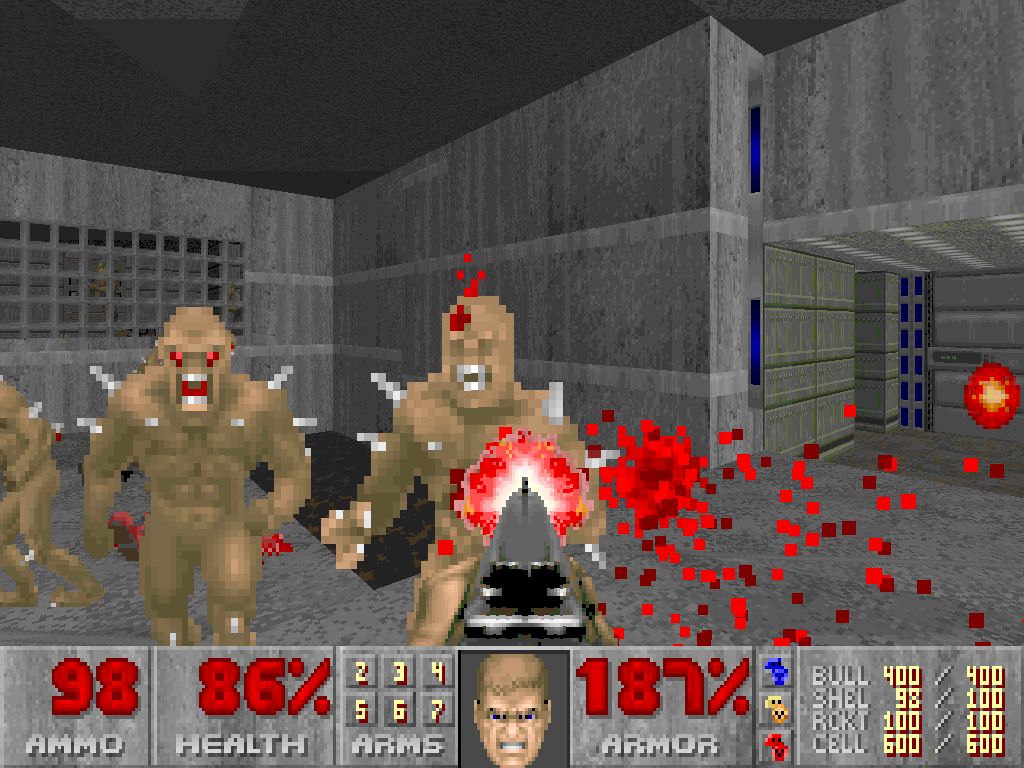DOOM wasn't the first FPS, but it certainly had the most impact of any. It helped bring about the ESRB ratings system, standardized the concept of both the "Space Marine" and the Silent Protagonist, and for a while FPSs were called "DOOM clones".
What made DOOM so much better than previous FPSs that it dominated the market, and why has it been considered one of the greatest games ever made over and over? Why is there a mod community still alive to this day, eighteen years after its first release?
 |
| The box art may have helped, too. |
But to begin with, we should start where every innovative game starts: with the mechanics.
Part I: The Mechanics
What did DOOM improve upon, and perhaps equally as important: what couldn't DOOM do? It's important to understand why certain features were left out -- surely some for technological reasons, but no matter what constraints of the day, some common features of modern FPSs were missing from DOOM.
Try jumping.
Jumping is one of the most commonplace mechanics in any action game. Mario, the most recognized videogame mascot ever, is known for jumping! So why can't you jump in DOOM? A quick guess would be that the developers didn't think it was necessary. After all, DOOM's predecessor, Wolfenstein 3D, was played entirely on a 2D plane, and the only vertical aspects, such as walls and enemies, were obstacles you weren't meant to jump over. In id's previous work, the level design warranted no jumping. Even with new vertical heights to climb in DOOM, old modes of thinking may have meant jumping was never conceived.
Today, people are so used to jumping in FPSs that a modern FPS player with no knowledge of DOOM's controls might wonder where that damn jump key is. There is even a fan-made patch that lets you jump -- although this bypasses a lot of the level design, and destroys some of the experience.
It's the simplicity of DOOM's mechanics that made it great, and made it quite accessible.
Look at all that's missing from DOOM:
No jumping
No z-axis aiming or panning (no looking up or down)
No manual ammo reload
No falling injuries
No dialogue or even NPCs
No secondary fire on any weapon
No mouse control
No crates or moveable objects
 |
| No sunshine. No lollipops. No rainbows. |
1-7: Weapons selection
Arrows: Movement
Ctrl: Fire weapon
Shift: Run
Space: Interact (Open doors and flip switches)
Esc: Menu
Tab: Check Map
Wait, sixteen? You call that accessible?
Yep. It's about the same number of buttons on a modern controller. Four of the keys (arrows) are self-explanatory, and Esc was used in many programs to bring up a menu. Weapon switching was rare in the middle of a battle unless you ran out of ammo, and if you did the game automatically switched to the next best thing without worrying. Similarly, you wouldn't want to check the map during a firefight, so of all of the keys, only three (ctrl, shift, spacebar) actually required memorization during battle. And the keys were customizable, so you could make the computer memorize your layout!
But but but if I can't aim or look up, how do I shoot monsters above me?
Automatic is the word of the day in DOOM. So much in DOOM was taken care of that all you needed to worry about was survival -- a task in itself.
From the perspective of a gamer at the time, control was such a chore in PC games (the very thing that games are all about!) that anything automatic was a godsend. Even today, we want so much automatically done in our games that we even parody that need with Idle games, non-interactive satires on RPGs.
 |
| Automatic like a chaingun. |
Streamlined controls are the Holy Grail of mechanics designers, and DOOM's control miraculously hasn't aged much. Each button is necessary and easy to learn, giving us a minimalism not seen is many FPSs today, yet giving us enough interactivity to feel like we're fully in control. There is nothing extraneous in its gameplay or level design to feel like we're gypped on controls. We don't need to pick up items by hand (automatic!) or solve complex puzzles (the maze layout of most levels is enough of a puzzle, and the use of a map screen (somehow missing from so many FPSs today) is a welcome addition to help with that.
As complicated as FPSs can be, DOOM's controls are simple and stripped down (well, for its time it was the best you had), giving it an accessability unmatched in the genre today. By this point, FPSs are one of the hardest of the hardcore genres, and what helps widen the net to catch more gamers is the invention of solid control schemes on console systems, showing that once again, even in a complicated genre, less is more.
In further chapters of our deconstruction of DOOM, we'll get into the motif, enemies, weapons, levels, story, and other aspects, but for now, this brief overview of the controls and mechanics serves as a good launching point for the deconstruction.
Read Part II: Motif
Read Part II: Motif
No comments:
Post a Comment